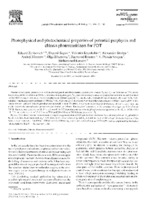| dc.description.abstract | Structural and optical properties as well as photophysical and photochemical parameters (excited S₁ and T₁ state lifetimes at 77 K and in the presence of O₂ in solution at 293 K; efficiencies of singlet oxygen, ¹Δg, generation) are presented for porphyrins and chlorins with potential for the PDT of cancer: chlorin p₆ and its trimethyl ester, chlorin e₆ and its Na₃ and K₃ salts, purpurin-18 and its monomethylester, 5,10,15,20-tetrakis(3-methoxyphenyl)porphyrin (TPPM), 5,10,15,20-tetrakis(2,4-difluoro-3-methoxyphenyl)porphyrin (TPPMF) and GaTTP in different solvents (ethanol, toluene, pyridine and buffer pH 7.4) at 77–300 K. It has been shown that for monomeric chlorin e₆, chlorin p₆ and its derivatives the photophysical parameters are similar, as follows: fluorescence lifetimes τₛ in the presence of oxygen are 3.2–4.5 ns at 293 K; fluorescence quantum yields φ₁ vary from 0.1 to 0.2 depending on the solvent; phosphorescence quantum yields φ₁ are of t order 10⁻⁵; T₁ state lifetimes τT = 1.5–2.0 ms at 77 K and 250–390 ns at 293 K in the presence of O₂. By use of the direct kinetic measurement of singlet oxygen emission at 1.27 μm on laserexcitation the quantum yields of ¹Δg generation by chlorins have been measured: φΔ = 0.35−0.68. In this case values of φ₁ and φΔ depend strongly on the solve probably because of the formation of aggregates. For TPPM, TPPMF and Ga-TPP the φΔ values measured are higher (0.87–0.98) and are explained by the higher intersystem crossing S₁ → T₁ quantum yields. | en |

